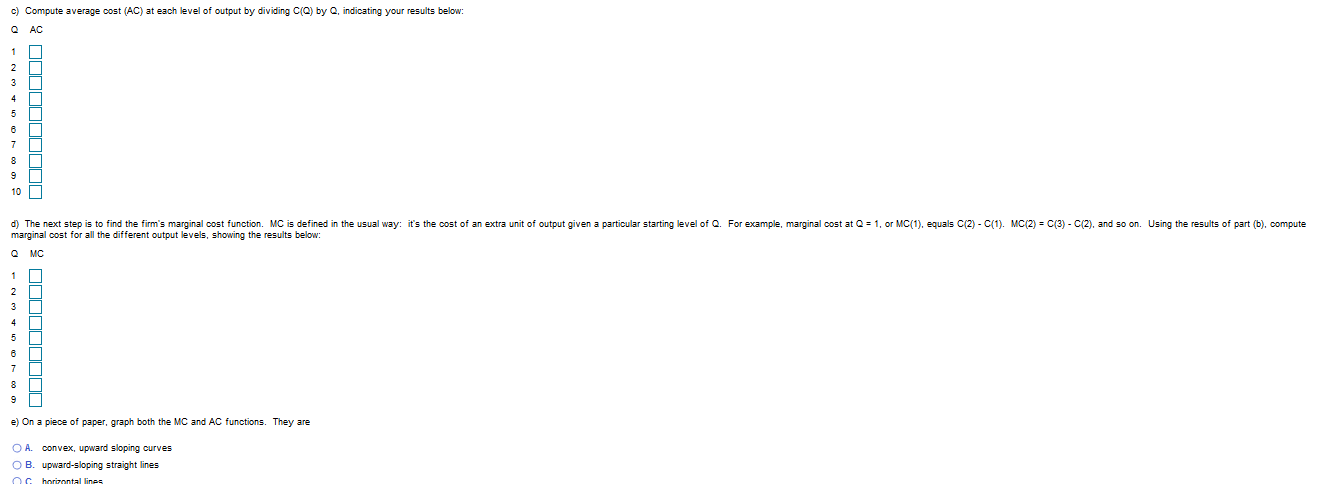c) Compute average cost (AC) at each level of output by dividing C(Q) by Q, indicating your results below: AC d) The next step is to find the firm's marginal cost function. MC is defined in the usual way: it's the cost of an extra unit of output given a particular starting level of Q. For example, marginal cost at Q 1, or MC(1), equals C(2) marginal cost for all the different output levels, showing the results below: C(1). MC(2) C(3) - C(2), and so on. Using the results of part (b). compute QMC 1 2 e) On a piece of paper, graph both the MC and AC functions. They are O A. convex, upward sloping curves O B. upward-sloping straight lines O horizontal lines
c) Compute average cost (AC) at each level of output by dividing C(Q) by Q, indicating your results below: AC d) The next step is to find the firm's marginal cost function. MC is defined in the usual way: it's the cost of an extra unit of output given a particular starting level of Q. For example, marginal cost at Q 1, or MC(1), equals C(2) marginal cost for all the different output levels, showing the results below: C(1). MC(2) C(3) - C(2), and so on. Using the results of part (b). compute QMC 1 2 e) On a piece of paper, graph both the MC and AC functions. They are O A. convex, upward sloping curves O B. upward-sloping straight lines O horizontal lines
Managerial Economics: Applications, Strategies and Tactics (MindTap Course List)
14th Edition
ISBN:9781305506381
Author:James R. McGuigan, R. Charles Moyer, Frederick H.deB. Harris
Publisher:James R. McGuigan, R. Charles Moyer, Frederick H.deB. Harris
ChapterB: Differential Calculus Techniques In Management
Section: Chapter Questions
Problem 5E
Related questions
Question
Suppose a firm uses capital (K) and labor (L) to produce widgets according to the production function Q =
K^(1/4)L^(1/4)
=
(KL)^(1/4),
where Q is output. The goal in this problem is to find the firm's total and marginal cost functions. In order to derive the cost function, the first step is to find the location of the cost-minimizing bundle on any given isoquant. To get a numerical answer, recall that the slope of an isoquant is
-MPL/MPK
(K is on the vertical axis). Using calculus, it can be shown that this slope formula reduces to -K/L. For example, consider the input bundle with K = 8, L = 2 on the isoquant with Q = 2 (note that 2 =
161/4
). The formula indicates that the slope at this point is -4 = -8/2. In fact, the formula tells us that regardless of which isoquant an input bundle is on, the slope will be -4 as long as the ratio of K to L is 4:1. Similarly, the isoquant slope will be -1 whenever the ratio of K to L is 1:1.In answering the following questions, use integer values only (don't enter unneeded decimal points).

Transcribed Image Text:c) Compute average cost (AC) at each level of output by dividing C(Q) by Q, indicating your results below:
AC
d) The next step is to find the firm's marginal cost function. MC is defined in the usual way: it's the cost of an extra unit of output given a particular starting level of Q. For example, marginal cost at Q 1, or MC(1), equals C(2)
marginal cost for all the different output levels, showing the results below:
C(1). MC(2) C(3) - C(2), and so on. Using the results of part (b). compute
QMC
1
2
e) On a piece of paper, graph both the MC and AC functions. They are
O A.
convex, upward sloping curves
O B.
upward-sloping straight lines
O horizontal lines
Expert Solution
This question has been solved!
Explore an expertly crafted, step-by-step solution for a thorough understanding of key concepts.
This is a popular solution!
Trending now
This is a popular solution!
Step by step
Solved in 8 steps with 6 images

Knowledge Booster
Learn more about
Need a deep-dive on the concept behind this application? Look no further. Learn more about this topic, economics and related others by exploring similar questions and additional content below.Recommended textbooks for you

Managerial Economics: Applications, Strategies an…
Economics
ISBN:
9781305506381
Author:
James R. McGuigan, R. Charles Moyer, Frederick H.deB. Harris
Publisher:
Cengage Learning



Managerial Economics: Applications, Strategies an…
Economics
ISBN:
9781305506381
Author:
James R. McGuigan, R. Charles Moyer, Frederick H.deB. Harris
Publisher:
Cengage Learning




Essentials of Economics (MindTap Course List)
Economics
ISBN:
9781337091992
Author:
N. Gregory Mankiw
Publisher:
Cengage Learning

Managerial Economics: A Problem Solving Approach
Economics
ISBN:
9781337106665
Author:
Luke M. Froeb, Brian T. McCann, Michael R. Ward, Mike Shor
Publisher:
Cengage Learning